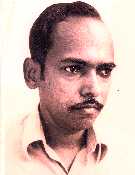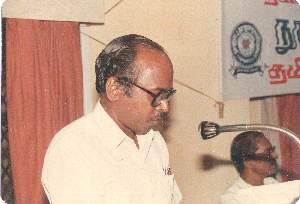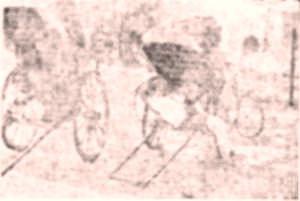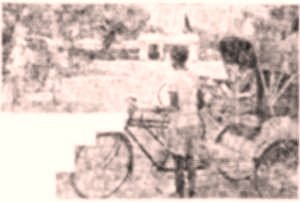

Home | Biodata | Biography | Photo Gallery | Publications | Tributes
Tamil Studies

 |

Home | Biodata | Biography | Photo Gallery | Publications | Tributes Tamil Studies |
 |


For those that pass by, but more particularly for those that pause and become customers, the rickshawmen customarily wait at just a few places in Tambaram - say 10 to 20 on each side of the railway station, with a few at the Tambaram East Park, a few at the corner of the Velacheri and Agaram roads and a few at the IAF gate. They spend a lot of time at these places ; watching, waiting, or even gradually rearing up a little shrine, with old rickshaw lamps for lights and a piece of railway asbestos plaster for its serpent hood.
Yet they haven't always been there : the very idea of a rickshaw is less than a century old, while they don't seem to have penetrated from their original place of invention, Japan, to Tambaram till about five years before independence, when a milkman from Kadaperi bought a number of rickshaws and let them out for hire at 4 annas a day. When he fell sick and didn't collect his rents, the rickshaws were simply retained by the rickshawmen.; though some were also bought out of savings by their pullers. When the first survey by Statistics students was held in 1960, very few of the rickshawmen were paying rent for their vehicles, though then as now the few who didn't have a licence to enter railway property (which includes the station approaches) had to rent a licence from somebody with one to spare, the charge being four annas. However, by 1965, with quite a few newcomers be- coming rickshaw-pullers, perhaps a third of the rickshawmen were paying 50 Paise a day rent.
Though nearly a half of the rickshaw- men left their native places (mainly Madurantakam taluk and South Arcot) more than ten years ago, only a third of them have been rickshawmen for ten years or more. Many were coolies or labourers before ; a few others had what might be regarded as better jobs ; serving in a hotel, lorry cleaning and even working in the college. In 1965, one-third were literate, but recently this proportion has increased. Before 1967, if a cycle rickshawman appeared in Tambaram he was chased out. However, the local rickshawmen were Congress supporters, so, after the D.M.K. victory, the local M.L.A. had no qualms about introducing cycle rickshaws. ' Let cycle rickshawmen also live' he argued. One Mr ' Reddiar' bought a few cycle- rickshaws and let them out for hire. Since cycle rickshaws were faster (more than double) and perhaps just because they were new the public preferred them. The ordinary rickshawmen moved their stand closer to the station exit, but to no avail; they had to change over, learning the new technique of pedalling cycle rickshaws. A few who couldn't left the trade ; some got work with the municipality. The old rickshaws were sold in an auction, for by September 1968 hardly anyone was using them any more. They were mostly used as firewood.
The cost of a new hand rickshaw is about Rs. 250 while a new cycle rickshaw costs Rs. 750 cash, or, by hire purchase, a down payment for Rs. 250 and thence Rs. 2 a day for ten months, making a payment of Rs. 850 all told. Only one or two rickshawmen bought their machines outright (one from the profits of gambling) while half a dozen borrowed Rs. 250 to make the down payment for hire purchase. Their borrowing was mostly from regular patrons, to be offset against future services, Some of them organised a chit-fund among themselves to buy vehicles. The rest are hiring their cycle rickshaws from capitalists, and paying a rent of Rs. 2 a day. Thus to be profitable to the rickshawmen the switch to cycle rickshaws must bring at least an extra Rs. 2 a day in receipts. However, it certainly is pro fitable to the hire purchase people, for their rate of interest (assuming all dues are in fact paid) works out at about 40% a year, while the capitalists renting rickshaws out make much more than this.
The rickshawmen's income comes from two sources, casual work and contracts, the latter mostly for carrying children to school. Contract work increased in im- portance during the last few years of the hand rickshaws and has continued into the cycle era, though less than half the men hold regular contracts. A couple of those who do earn sizeable amounts from them-up to Rs. 100 a month-while possession of a contract doesn't seem to dampen a man's enthusiasm for casual work: the average number of casual trips performed by rickshawmen with contracts was no less than the number worked by men with- out. This resulted in considerable inequa- lities of income among the rickshawmen. Table II summarises the information gained on the amount of casual work done and the fares charged, measuring work of trip. This latter is measured in ' miles ' -that is, an average sort of mile as esti- mated mentally by the rickshawmen them- selves, and perhaps related to the statute mile, perhaps not. From the table we can conclude that, provided the average rickshawmen's mental ' mile' hasn't changed so as to spoil the statistics, they were tending to go for fewer and longer journeys a day, so keeping the ' mileage' travelled with casual passengers fairly constant at a little less than three ' miles ' a day.
The fare charged to any particular customer is a matter of bargaining, the rickshawmen not hesitating to charge what the traffic can bear. In terms of Paise a ' mile', the highest fare recorded was up to seven times the cheapest. However, on the average the fares charged were fairly rational, as Table III shows. More often than not the individual rickshawman charged the same fare for the same distance, while most of the time he charged a higher fare for a longer distance. Typically, his fares increased at a constant or diminishing rate per 'mile'-which is the same as bus and taxi fares.
During the decade there were two main increases in the level of fares, once around 1962-3-4 and again by about 50% upon the introduction of cycle-rickshaws. In the days of hand rickshaws it was increasing fares rather than increased work which brought a rising money income; however, with cycle rickshaws longer journeys are possible (even as far as the city after the last bus at night), so the average trip distance has risen as well as the fare. Those who changed over to cycle rickshaws early on had some initial advantage and performed many more trips daily, but now that everybody has changed over (plus a few new entrants) the number of trips per man has sunk to normal. The end result is that the cycle rickshawmen who depend on casual traffic only have just enough extra revenue to pay the Rs. 2 a day hire charges and be left with a spendable income much as before. The only difference is that the return journey of three ' miles ' each way that was their then daily work took them something over an hour with a hand rickshaw, while now the daily grind takes less than an hour to perform. The rickshawmen were asked to estimate not only their daily income but also their daily spending, thus giving two rough estimates which for some years diverge more than they should. However, from Table IV it would seem that their incomes/spending have increased more or less in line with the price level, and lie somewhat above the level of wage of an unskilled labourer. The extra benefits are that the rickshawman has a greater certainty of work (though often at odd hours of the day) and that he spends most of his time resting, waiting. Most of the men owned kachcha houses on government land and so neither had to pay house-rent nor to spend the night in their rickshaws. Most had large families, and children at school receiving free education. As for the ways of spend- ing money: mostly on food, something on tobacco and perhaps a cryptic comment about there being plenty of kalakkal (sly grog) shops in Tambaram.
The surveys were conducted as part of
the practical training for students of
Statistics. We wish to acknowledge
specially the help of B. G. Sither (1960),
Murali Mohan (1965) and K. Narayanan
(1969). K. Narayanan's report on the
cycle richshaws appears in the same issue
under the title ' richshaw cycle rickshaw'
(a poem in Tamil).
Table1
Numbers
| March 1960 | Nov. 1962 | Nov. 1965 | July 1967 | Jan. 1969 | |
| Number of rickshawmen | 36 | 32 | 47 | 27 | 41 |
| Approx. rickshaw licenses on issue | 70 | 90 | |||
| No. receiving contract & other additional income | 17 | 16 | |||
| No. renting/hiring | 4 | 9 | 20 | 11 | 40 |
TABLE I I
DISTANCES AND FARES FOR CASUAL TRAFFIC
| Year | 1960 | 1962 | 1965 | 1967 | 1969 |
| Average trip distance ('miles') | 0.95 | 1.2 | 1.1 | 1.2 | |
| Casual trips per man/day | 3.1 | 2.8 | 2.4 | 2.3 | |
| Casual ' miles' per man/day | 2.8 | 3.1 | 2.7 | 2.8 | 3.5 |
| Casual fares per ' mile ' | |||||
| Highest rate (Rs.) | 1.50 | 1.50 | 1.50 | 2.00 | |
| Average rate (Rs.) | 0.55 | 0.70 | 1.00 | 0.95 | 1.50 |
| Lowest rate (Rs.) | 0.18 | 0.29 | 0.30 | 0.40 | |
| Average income from casual fares, per day (Rs.) | 1.50 | 2.20 | 2.70 | 2.50 | 5.30 |
Figures for 1969 refer to cycle rickshaws.
TABLE III
COMPARISON OF CASUAL FARES CHARGED BY INDIVIDUAL RICKSHAWMEN
| ' Normal' Fares: | 1960 | 1965 | 1967 |
| Same fare for same distance | 11 | 8 | 15 |
| Higher fare for longer distance : | |||
| Constant rate per 'mile' | 5 | 11 | 13 |
| Falling rate per 'mile' | 6 | 37 | 14 |
| Rising rate per' mile' | 9 | 19 | 7 |
| Total 'Normal' fares : | 31 (72%) | 75 (83%) | 49 (84%) |
| ' Abnormal' Fares : | |||
| Distance same, fare different | 4 | 11 | 5 |
| Fare same, distance different | 6 | 3 | 2 |
| Higher fare for shorter distance | 2 | 1 | 2 |
| Total 'Abnormal' fares: | 12(28%) | 15(17%) | 9(16%) |
| TOTAL: | 43 | 90 | 58 |
The units in this table are pairs of fares. If a rickshawman makes two journeys in a day, the comparison of them gives one observation. Three journeys gives three observations (1-2, 1-3, 2-3), four journeys 6 (1-2, 1-3, 1-4, 2-3, 2-4, 3-4), etc.
Table IV
Income and Spending
| 1960 | 1962 | 1965 | 1967 | 1969 | |
| Average receipts from casual fares | |||||
| (Rs./day) | 1.50 | 2.20 | 2.70 | 2.50 | 5.00 |
| Estimated average receipts from con- tracts (Rs./day) | 0.40 | O.60 | 0.80 | 1.50 | 1.35 |
| Total | 1.90 | 2.80 | 3.50 | 4.00 | 6.65 |
| Less average rent/maintenance | 0.05 | 0.20 | 0.30 | 0.30 | 2.00 |
| Net average income | 1.85 | 2.60 | 3.10 | 3.80 | 4.65 |
| Estimated average spending (including debt reduction) | 1. 80 | 2.80 | 2.90 | 4.00 | 4.10 |
| At 1949 prices | 1.25 | 1.90 | 1.45 | 1.85 | 1. 80 |
1949 prices-taken from Consumer Price Index (working class, Madras). Figures for 1969 refer to cycle rickshaws. D.P., MADRAS, 1969.